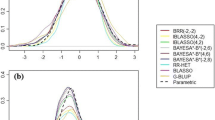Abstract
This paper presents theory and methods to compute genotypic means and covariances in a two breed population under dominance inheritance, assuming multiple unlinked loci. It is shown that the genotypic mean is a linear function of five location parameters and that the genotypic covariance between relatives is a linear function of 25 dispersion parameters. Recursive procedures are given to compute the necessary identity coefficients. In the absence of inbreeding, the number of parameters for the mean is reduced from five to three and the number for the covariance is reduced from 25 to 12. In a two-breed population, for traits exhibiting dominance, the theory presented here can be used to obtain genetic evaluations by best linear unbiased prediction and to estimate genetic parameters by maximum likelihood.
Similar content being viewed by others
References
De Boer IJM, Hoeschele I (1993) Genetic evaluation methods for populations with dominance and inbreeding. Theor Appl Genet 86:245–258
Dickerson GE (1973) Inbreeding and heterosis in animals. In: Anim Breed Genet Symp in Honor of Dr. J. L. Lush. Am Soc Anim Sci and Am Dairy Sci Assoc, Champaign Ill, pp 54–77
Eisen EJ, Horstghen-Schwark G, Saxton AM, Bandy TR (1983) Genetic interpretation and analysis of diallel crosses with animals. Theor Appl Genet 65:17–23
Falconer DS (1989) Introduction to quantitative genetics, 3rd edn. Longman, Inc., New York
Gillois M (1964) La relation d'identité en genetique, [Genetic identity relationship]. PhD thesis, Faculty of Science Paris. In: Jacquard A Eds (1974) The genetic structure of populations. Springer-Verlag. Germany, pp 104–107
Harris DL (1964) Genotypic covariances between inbred relatives. Genetics 50:1319–1348
Harville DA (1976) Maximum likelihood appproaches to variance component estimation and to related problems. J Am Stat Assoc 72:320–340
Henderson CR (1973) Sire evaluation and genetic trends. In: Anim Breed Genet Symp in Honor of Dr. J. L. Lush. Am Soc Anim Sci and Am Dairy Sci Assoc, Champaign, Ill, pp 10–41
Henderson CR (1976) A simple method for computing the inverse of a numerator relationship matrix used in prediction of breeding values. Biometrics 32:69–83
Hill WG (1982) Dominance and epistasis as components of heterosis. J Anim Breed Genet 99:161–168
Hoeschele I, VanRaden PM (1991) Rapid method to compute inverses of dominance relationship matrices for noninbred populations by including sire by subclass effects. J Dairy Sci 74:557–569
Jacquard A (1974) The genetic structure of populations. SpringerVerlag, Germany
Kempthorne O (1954) The correlation between relatives in a random mating population. Proc Roy Soc Lond B143:103–113
Kempthorne O, Folks L (1971) Probability, statistics, and data analysis. Iowa State University Press
Lo LL (1993) Genetic evaluation and selection in multibreed populations. PhD thesis, University of Illinois, Urbana
Lo LL, Fernando RL, Grossman M (1993) Covariance between relatives in multibreed populations: Additive model. Theor Appl Genet 87:423–430
Smith SP, Mäki-Tanila A (1990) Genotypic covariance matrices and their inverses for models allowing dominance and inbreeding. Genet Sel Evol 22:65–91
VanRaden PM (1992) Accounting for inbreeding and crossbreeding in genetic evaluation of large populations. J Dairy Sci 75:3136–3144
Wei M, Van der Werf JHJ (1994) A mixed linear mixed model for combined crossbred and purebred selection. Anim Prod 59:400–413
Wei M, Van der Steen HAM, Van der Werf JHJ (1991a) Relationship between purebred and crossbred parameters. I. Variances and covariances under the one-locus model. J Anim Breed Genet 108:253–261
Wei M, Van der Steen HAM, Van der Werf JHJ (1991b) Relationship between purebred and crossbred parameters. II. Genetic correlation between purebreed and crossbred performance under the model with two loci. J. Anim Breed Genet 108:262–269
Author information
Authors and Affiliations
Additional information
Communicated by E. J. Eisen
Supported in part by the Illinois Agricultural Experiment Station, Hatch Projects 35-0345 (R.L.F.) and 35-0367 (M.G.). A computer program implementing the methods described here is available upon request to R.L.F.
Rights and permissions
About this article
Cite this article
Lo, L.L., Fernando, R.L., Cantet, R.J.C. et al. Theory for modelling means and covariances in a two-breed population with dominance inheritance. Theoret. Appl. Genetics 90, 49–62 (1995). https://doi.org/10.1007/BF00220995
Received:
Accepted:
Issue Date:
DOI: https://doi.org/10.1007/BF00220995




